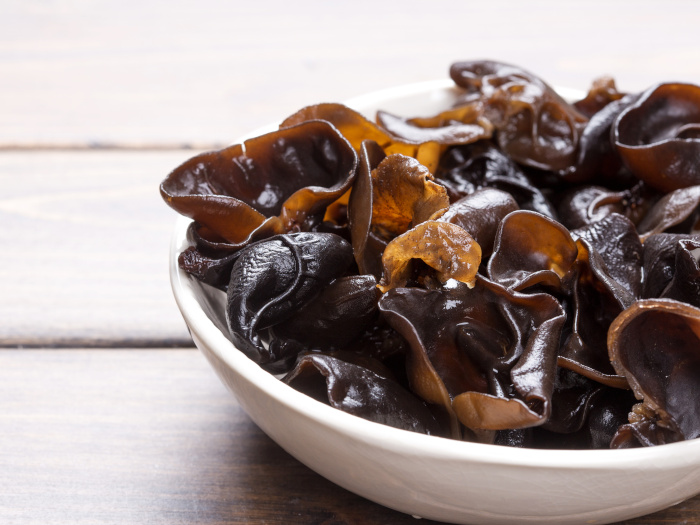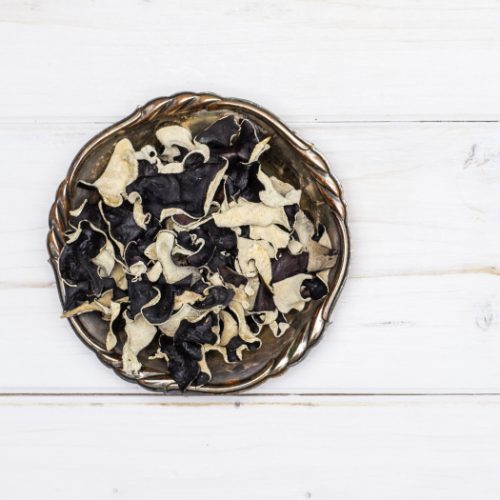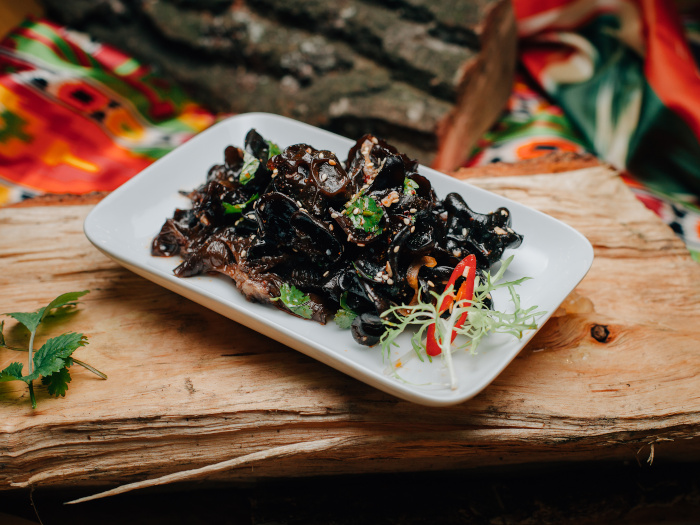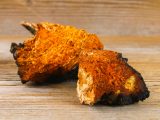You may have most likely eaten wood ear mushrooms in your hot and sour soup and have not realized that you are eating a popular Chinese black fungus. These jelly-like black mushrooms soak the flavors of hot spicy soups and offer a delightful chewiness without taking over the dish. They are used in several Asian dishes as well as in traditional Chinese medicine as they are known to have antiviral properties.
What Are Wood Ear Mushrooms?
Wood ear mushrooms (Auricularia auricula-judae) are large mushrooms that grow as crinkly clusters on old logs or decaying wood stumps in the wild. They are often called tree ears as they resemble ears on a tree, with a veined appearance on the outside and a wrinkled texture on the inside. They have been cultivated for more than 2100 years and are one of the most popular mushrooms used in China. Wood ear mushrooms have gained popularity in the US and Europe too. You can also find them in certain damp woods in the US, Canada, Europe, and certain parts of India. However, they are mostly cultivated and sold in their dry form in select stores. [1] [2]

Wood ear mushroom is the classic addition to the hot and sour soup. Photo Credit: Shutterstock
Wood ear mushrooms are often called black fungus, but they are a little different. To know more about black fungus, you can visit 6 Proven Benefits of Black Fungus.
Nutrition Facts & Benefits
Wood ear mushrooms are low in calories and fat, like most other mushrooms. According to the USDA, one cup of dried Asian mushrooms (145 grams) has 81 calories, 2.25 grams of protein, and almost zero fat content. They are rich in B vitamins and minerals like copper and selenium. [3]
Wood ear mushrooms are antioxidant-rich, which is why perhaps the Chinese believe them to be beneficial for overall blood circulation and well-being. A few studies have shown that these mushrooms may help regulate blood sugar levels and have antimicrobial properties. However, further studies are required to understand the therapeutic potential of these mushrooms. [4] [5]
How To Cook Wood Ear Mushrooms?
Wood ear mushrooms have little flavor on their own but they soak up the liquids and spices they are cooked in. The chewy consistency, along with the spiced flavors of the broth they are cooked in, make these mushrooms a delicacy. It is best to use store-bought dried mushrooms, which need to be cooked before consumption. Dried wood ear mushrooms do not need to be soaked for more than 2-3 hours. You can speed up the process with hot water. While these mushrooms are generally added to soups and noodles, here is a recipe for an Asian cold salad that is tangy and easy and can be served all-year-around.

Wood Ear Mushroom Asian Salad Recipe
Ingredients
- 4 cups wood ear mushrooms rehydrated
- 3 garlic cloves finely chopped
- 1 red chili pepper chopped
- 1 tbsp soy sauce light
- 1 tbsp Chinese black vinegar
- 1 tsp sesame oil
- 1 tbsp cilantro chopped
- 1 tsp sesame seeds
Instructions
- First, you will need to rehydrate the dried mushrooms. 1 cup of dried mushrooms will approx yield 4 cups of rehydrated wood ear mushrooms.
- In a medium-sized pot, cook the mushrooms in boiling water for 3-4 minutes. Turn the heat off and let it steep for 15-20 minutes or until soft.
- Drain and rinse well in cold water. Let it dry completely. You can also use a salad spinner to remove the excess water. Trim off the hard stems, if any. You can keep it as it is or cut into smaller pieces if you prefer.
- In a large salad bowl, add the garlic, chili peppers, soy sauce, Chinese black vinegar, and sesame oil. Blend well. Now, add the cooked wood ear mushrooms and toss to coat it all over.
- Refrigerate it for an hour so that the mushrooms are marinated. Toss it once or twice during this time to make sure the sauce does not settle at the bottom.
- Garnish with chopped cilantro and sesame seeds. Serve cold as an appetizer or a side dish.

Notes
Other Wood Ear Mushroom Recipe Ideas
Most dried mushrooms have a long shelf life, sometimes up to two years, if kept in a clean airtight container. But we encourage you to experiment and use these delicious wood ear mushrooms in different dishes. Here are our favorites:
- Soups: You can add them to any Asian soup such as this Immunity-Boosting Miso Soup. Remember to add them in the end so that they retain their slight crunchiness and do not become too soggy.
- Noodles & Stir-fries: Toss cold Soba Noodles with soy sauce, thinly shredded carrot, and sautéed garlicky mushrooms. Top with sesame seeds.
- Jazzing Up a Dish: Try an East-meets-West combination and add them to a classic alfredo fettuccini or a simple Chicken Soup.
- Side Dish: These mushrooms go well with all kinds of meat but complement pork dishes very well like this Tender And Juicy Pork Loin Roast.
Word of Caution: Wood ear mushrooms do not generally have any side effects. However, do not consume them raw. Dried mushrooms need to be reconstituted properly; sometimes, boiling dried mushrooms may even increase antioxidant activity. Do not store rehydrated mushrooms in water in the refrigerator or freezer as they can get cross-contaminated. It is best to hydrate as much as you need and use it for the dish immediately. [6]
Foraging for wild mushrooms is not recommended unless you are with an experienced person as some mushrooms can be poisonous or even fatal.


